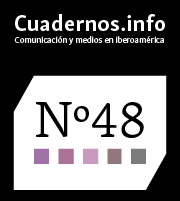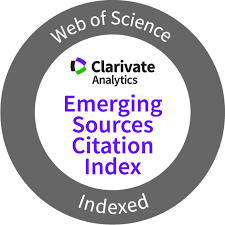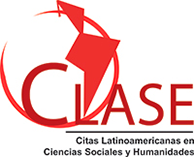Electoral campaigns and Twitter. The dissemination of media content in the digital environment
DOI:
https://doi.org/10.7764/cdi.48.27679Keywords:
political communication, election campaign, social media, Twitter, television, hybridizationAbstract
During the last decades, social media have significantly transformed the field of political communication. Political parties and politicians have incorporated these platforms as a regular tool in their communication strategy. In turn, the mainstream media continues to play a key role in the political and social sphere. In this context marked by the coexistence between traditional media and social media, political actors take advantage of the potential of both communication spaces to expand the dissemination of their message. This research examines the relationship between mass media and Twitter during the 2016 election campaign in Spain. The methodology combines the quantitative content analysis and the metric analysis on a sample of 8199 messages published by the four most voted political parties: PP, PSOE, Podemos and Ciudadanos. The results confirm that parties take advantage of Twitter to amplify the impact of their interventions in mass media, being especially significant the debate broadcast on television. This data reinforces the idea that old and new media coexist and complement each other in a hybrid communicative environment.
Downloads
References
Alonso-Muñoz, L., Marcos-García, S., & Casero-Ripollés, A. (2017). Political leaders in (inter) action. Twitter as a strategic communication tool in electoral campaigns. Trípodos, (39), 71-90.
Alonso-Muñoz, L., Miquel Segarra, S., & Casero-Ripollés, A. (2016). Un potencial comunicativo desaprovechado. Twitter como mecanismo generador de diálogo en campaña electoral. [An untapped communicative potential. Twitter as mechanism to generate dialogue in electoral campaign]. Obra digital: revista de comunicación, (11), 39-59. http://dx.doi.org/10.25029/od.2016.100.%25x
Anstead, N., & O’Loughlin, B. (2011). The emerging viewertariat and BBC question time: Television debate and real-time commenting online. The international journal of press/politics, 16(4), 440-462. https://doi.org/10.1177/1940161211415519
Bentivegna, S. (2015). A colpi di tweet: la politica in prima persona. Bolonia: Il Mulino.
Broersma, M., & Graham, T. (2013). Twitter as a news source: How Dutch and British newspapers used tweets in their news coverage, 2007–2011. Journalism practice, 7(4), 446-464. https://doi.org/10.1080/17512786.2013.802481
Casero-Ripollés, A., Feenstra, R. A., & Tormey, S. (2016). Old and new media logics in an electoral campaign: The case of Podemos and the two-way street mediatization of politics. The international journal of press/politics, 21(3), 378-397.
https://doi.org/10.1177/1940161216645340
Casero-Ripollés, A. (2008). Modelos de relación entre periodistas y políticos: La perspectiva de la negociación constante [Models of relationship between journalists and politicians: The perspective of constant negotiation]. Estudios sobre el mensaje periodístico, 14, 111-129. ISSN: 1134-1629
Castells, M. (2009). Comunicación y poder [Comunication and power]. Barcelona: Alianza.
Ceccarini, L. (2015). La cittadinanza in rete [Citizenship on the net]. Bolonia: Il Mulino.
Cha, M., Haddadi, H., Benevenuto, F., & Gummadi, K. P. (2010, May). Measuring user influence in twitter: The million follower fallacy. Icwsm, 10(10-17), 30.
Chadwick, A. (2017). The hybrid media system: Politics and power. Oxford: Oxford University Press.
Chadwick, A. (2011). The political information cycle in a hybrid news system: The British prime minister and the “Bullygate” affair. The International Journal of Press/Politics, 16(1), 3-29. https://doi.org/10.1177/1940161210384730
Criado, J. I., Martínez-Fuentes, G., & Silván, A. (2013). Twitter en campaña: las elecciones municipales españolas de 2011 [Twitter in campaign: the Spanish municipal elections of 2011]. RIPS. Revista de Investigaciones Políticas y Sociológicas, 12(1), 93-113. ISSN 1577-239X
Freelon, D., & Karpf, D. (2015). Of big birds and bayonets: Hybrid Twitter interactivity in the 2012 presidential debates. Information, Communication & Society, 18(4), 390-406. https://doi.org/10.1080/1369118X.2014.952659
Gainous, J., & Wagner, K. M. (2014). Tweeting to power: The social media revolution in American politics. Oxford: Oxford University Press.
Graham, T., Broersma, M., Hazelhoff, K., & Van'T Haar, G. (2013). Between broadcasting political messages and interacting with voters: The use of Twitter during the 2010 UK general election campaign. Information, communication & society, 16(5), 692-716. https://doi.org/10.1080/1369118X.2013.785581
Hanna, A., Wells, C., Maurer, P., Friedland, L., Shah, D., & Matthes, J. (2013). Partisan alignments and political polarization online: A computational approach to understanding the French and US presidential elections». In: Weber, I., Popescu, A. M. & Pennacchiotti, M. (Eds.) Proceedings of the 2nd workshop politics, elections and data. Nueva York: ACM, 2013, p. 15-21.
Holtz-Bacha, C. (2013). Web 2.0: nuevos desafíos en comunicación política [Web 2.0: new challenges in political communication]. Diálogo político, 30(1), 11-27.
Hosch-Dayican, B. (2014). Online political activities as emerging forms of political participation: How do they fit in the conceptual map?. Acta politica, 49(3), 342-346. https://doi.org/10.1057/ap.2014.7
Iannelli, L. (2016). Hybrid Politics: Media and Participation. Londres: SAGE.
Jackson, N., & Lilleker, D. (2011). Microblogging, constituency service and impression management: UK MPs and the use of Twitter. The journal of legislative studies, 17(1), 86-105. https://doi.org/10.1080/13572334.2011.545181
Jenkins, H. (2006). Convergence culture: Where old and new media collide. Nueva York: NYU Press.
Jewitt, R. (2009). The trouble with twittering: Integrating social media into mainstream news. International Journal of Media and Cultural Politics, 5(3), 233-240. http://dx.doi.org/ 10.1386/macp.5.3.231/3
Jungherr A. (2014). Twitter in politics: a comprehensive literature review. Disponible en SSRN 2402443. http://dx.doi.org/10.2139/ssrn.2402443
Karlsen, R., & Enjolras, B. (2016). Styles of social media campaigning and influence in a hybrid political communication system: Linking candidate survey data with Twitter data. The International Journal of Press/Politics, 21(3), 338-357. https://doi.org/10.1177/1940161216645335
Kim, Y. (2011). The contribution of social network sites to exposure to political difference: The relationships among SNSs, online political messaging, and exposure to cross-cutting perspectives. Computers in Human Behavior, 27(2), 971-977. https://doi.org/10.1016/j.chb.2010.12.001
Kruikemeier, S. (2014). How political candidates use Twitter and the impact on votes. Computers in human behavior, 34, 131-139. https://doi.org/10.1016/j.chb.2014.01.025
Larsson, A.O. (2016). Online, all the time? A quantitative assessment of the permanent campaign on Facebook. New media & society, 18(2), 274-292. https://doi.org/10.1177/1461444814538798
Larsson, A.O. (2017). The news user on social media: A comparative study of interacting with media organizations on Facebook and Instagram. Journalism studies, 1-18. doi: http://doi.org/10.1080/1461670X.2017.1332957
Lilleker, D. G., Tenscher, J., & Štětka, V. (2015). Towards hypermedia campaigning? Perceptions of new media's importance for campaigning by party strategists in comparative perspective. Information, Communication & Society, 18(7), 747-765. https://doi.org/10.1080/1369118X.2014.993679
López-Meri, A., Marcos-García, S., & Casero-Ripollés, A. (2017). What do politicians do on Twitter? Functions and communication strategies in the Spanish electoral campaign of 2016. El profesional de la información, 26(5), 795-804.
López-Meri, A., & Casero-Ripollés, A. (2017). Las estrategias de los periodistas para la construcción de marca personal en Twitter: posicionamiento, curación de contenidos, personalización y especialización [The strategies of journalists for building personal branding on Twitter: positioning, curation of content, personalization and specialization]. Revista Mediterránea de Comunicación/ Mediterranean Journal of Communication, vol. 8, núm. 1, p. 59-73. doi: 10.14198/MEDCOM2017.8.1.5
Marchetti, R., & Ceccobelli, D. (2016). Twitter and television in a hybrid media system: the 2013 Italian election campaign. Journalism Practice, 10(5), 626-644. https://doi.org/10.1080/17512786.2015.1040051
Marcos-García, S., Alonso-Muñoz, L., & Casero-Ripollés, A. (2017). Usos ciudadanos de Twitter en eventos políticos relevantes. La# SesiónDeInvestidura de Pedro Sánchez [Citizen uses of Twitter in relevant political events. The #Session ofInvestiture of Pedro Sánchez]. Comunicación y hombre, (13), 25-49.
Mascaro, C., & Goggins, S. P. (2012). Twitter as virtual town square: Citizen engagement during a nationally televised Republican primary debate. APSA 2012 Annual Meeting Paper.
Murthy, D. (2013). Twitter: Social communication in the Twitter age. Hoboken, Nueva Jersey: John Wiley & Sons.
Norquay, G. (2008). Organizing without an organization: The Obama networking revolution. Policy Options, 29(9), 6-11.
Papacharissi, Z., & de Fatima Oliveira, M. (2011, September). The rhythms of news storytelling on Twitter: Coverage of the January 25th Egyptian uprising on Twitter. In World Association for Public Opinion Research Conference (Vol. 312, p. 3188).
Parmelee, J. H., & Bichard, S. L. (2011). Politics and the Twitter revolution: How tweets influence the relationship between political leaders and the public. United Kingdom: Lexington Books
Piscitelli, A. (2011). Prólogo: Twitter, la revolución y los enfoques ni-ni [Prologue: Twitter, the revolution and the ni-ni approaches]. In Orihuela, J. L. Mundo Twitter, 15-20.
Rega, R. (2016). Twitter as a New Engagement Opportunity. Analysis of the Questions and Answers between the Italian Prime Minister and Citizens. Trípodos, (39), 91-107.
Rodríguez, R., & Ureña, D. (2011). Diez razones para el uso de Twitter como herramienta en la comunicación política y electoral [Ten reasons for the use of Twitter as a tool in political and electoral communication]. Comunicación y pluralismo, 10, 89-116.
Rossi, L., & Magnani, M. (2012, May). Conversation practices and network structure in Twitter. In Sixth International AAAI Conference on Weblogs and Social Media, 563-566.
Shamma, D. A., Kennedy, L., & Churchill, E. F. (2009, October). Tweet the debates: understanding community annotation of uncollected sources. In Proceedings of the first SIGMM workshop on Social media (pp. 3-10). ACM.
Strömbäck, J. (2008). Four phases of mediatization: An analysis of the mediatization of politics. The international journal of press/politics, 13(3), 228-246. https://doi.org/10.1177/1940161208319097
Stromer-Galley, J. (2014). Presidential campaigning in the Internet age. Oxford University Press.
Trilling, D. (2015). Two different debates? Investigating the relationship between a political debate on TV and simultaneous comments on Twitter. Social science computer review, 33(3), 259-276. https://doi.org/10.1177/0894439314537886
Vergeer, M., Hermans, L., & Sams, S. (2013). Online social networks and micro-blogging in political campaigning: The exploration of a new campaign tool and a new campaign style. Party politics, 19(3), 477-501. https://doi.org/10.1177/1354068811407580
Wohn, D. Y., & Na, E. K. (2011). Tweeting about TV: Sharing television viewing experiences via social media message streams. First Monday, 16(3). https://doi.org/10.5210/fm.v16i3.3368
Downloads
Published
How to Cite
Issue
Section
License
Copyright (c) 2021 Cuadernos.info

This work is licensed under a Creative Commons Attribution-ShareAlike 4.0 International License.














